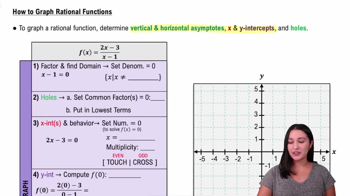Here are the essential concepts you must grasp in order to answer the question correctly.
One-to-One Function
A one-to-one function is a type of function where each output value is associated with exactly one input value. This means that no two different inputs produce the same output. To determine if a function is one-to-one, one can use the horizontal line test: if any horizontal line intersects the graph of the function more than once, the function is not one-to-one.
Recommended video:
Decomposition of Functions
Graphing Rational Functions
Rational functions are expressed as the ratio of two polynomials. The function given, y = (x + 4) / (x - 3), is a rational function. Understanding how to graph rational functions involves identifying asymptotes, intercepts, and the general shape of the graph, which can help in visualizing whether the function is one-to-one.
Recommended video:
How to Graph Rational Functions
Asymptotes
Asymptotes are lines that a graph approaches but never touches. For the function y = (x + 4) / (x - 3), there is a vertical asymptote at x = 3, where the function is undefined. Recognizing asymptotes is crucial for understanding the behavior of the function and can influence whether the function is one-to-one, especially in the context of its range.
Recommended video:
Introduction to Asymptotes
 Verified step by step guidance
Verified step by step guidance Verified video answer for a similar problem:
Verified video answer for a similar problem:



 4:56m
4:56m